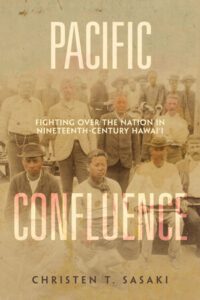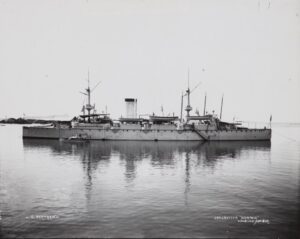By Christen T. Sasaki, author of Pacific Confluence: Fighting over the Nation in Nineteenth-Century Hawai‘i
Typically, the history of U.S. empire is told as a story of inevitable expansion. Within this narrative, the U.S. occupation of Hawaiʻi and the militarized nature of everyday life in the islands are framed as events that were meant to be. In other words, Hawaiʻi is understood and imagined only in relation to the United States — as a territory and state already and always in the making. But Pacific Confluence: Fighting over the Nation in Nineteenth-Century Hawaiʻi, challenges us to tell another story, to rupture the narrative of inevitability by considering what could have been and what still could be. It demonstrates how an island-centered perspective opens up different ways of seeing and understanding imperial expansion by foregrounding oceanic connectivities and circulations of power.

Take for example, the little-known story of Yosaku Imada’s 1893 escape from Oahu Prison. Imada was one of thousands of Issei —or first generation Japanese— migrants who traveled to Hawaiʻi with dreams of economic prosperity. He was assigned to work on a sugar plantation in Wahieʻe, Maui and while there, he got married. In early April 1892, Imada returned home from a long day in the fields to find his wife in bed with a fellow Issei named Kanazawa, and proceeded to kill them with his hatchet. Imada was found guilty of second-degree murder under the Hawaiian Kingdom’s judicial system and sent to Oahu Prison in September 1892.
On March 16, 1893, Imada was on work detail at Kamokuʻākulikuli — Oʻahuʻs reef-based “Quarantine Island.” As he toiled under the observation of several guards, he noticed the Japanese warship, the Naniwa, anchored offshore and decided to attempt an escape. Imada jumped into the ocean and swam to the ship, where he was quickly taken onboard. Although he had no intention of creating a diplomatic crisis, this former contract laborer’s early morning escape made headlines in both the U.S. and Japan.
Imada’s actions highlighted the uncertainties within the politically ambiguous archipelago, and the debate over his release presented the provisional government of Hawaiʻi with one of its first diplomatic controversies. The question that multiple political factions asked was: Who held power over Imada in this instance? The Japanese, the Kingdom of Hawaiʻi, or the newly established provisional government? Imada was convicted under the Kingdom of Hawaiʻiʻs judicial system. Yet by the time he swam for his freedom in March 1893, the monarchy had been overthrown by the haole (white, foreign)-led oligarchy, who then established a provisional government. Had the Naniwa been a merchant ship, it would have been subject to the provisional government’s authority. As a vessel of war, however, the Japanese shipcarried its national sovereignty on board and the two-month-old provisional government had yet to forge an extradition treaty with Japan.
Leaders in the United States understood that with over fifty years of interest vested in the islands, the future of Hawaiʻi was of great strategic importance to an “American Pacific.” U.S. officials kept close tabs on the “escapee incident” while Japanese politicians who understood the significance of Hawaiʻi to their country’s imperial ambitions viewed negotiating for the right to protect Imada as an opportunity to seek recognition on equal footing with western powers.

Brother Bertram Collection.
When compared to the overthrow or U.S. annexation, the case of an escaped Japanese prisoner might seem like a non-event in history. But positioning this incident within a web of competing interests and political actors vying for power reveals how seemingly inconsequential acts took on larger historical significance simply because of where and when they occurred. Imada’s act of seeking refuge onboard the Naniwa forced Japan and the U.S. to grapple with issues of race-based citizenship and state-based jurisdiction, as questions concerning the extraterritorial reach of each of the developing empires pushed political leaders to contemplate who could claim state protection and in this case, who held jurisdiction over Imada’s body.
Imada was ultimately expelled from the Naniwa in April 1893. Apparently the Japanese government did not deem his freedom relevant enough to cause a heightened political rift with the United States. According to eyewitness reports, he was brought to shore in a small rowboat and was set free on Dillingham Coal Wharf. Jailers from the provisional government were aware of Imada’s drop-off and were waiting to ambush him. News reports indicate that the Japanese sailors who brought Imada to shore were disappointed that he did not have the opportunity to run the gauntlet. They were, evidently, wagering on his getaway.
Imada’s story was the first of many I encountered that pushed me to write a Hawaiʻi-based history of late-nineteenth century imperialism and tell it in a way that refuses to normalize colonial dispossession, racial domination, and military occupation. By exploring histories that don’t fit neatly within the narrative of American expansion, Pacific Confluence reminds us that U.S. empire is not only not inevitable, but also contains the seeds of its own undoing.